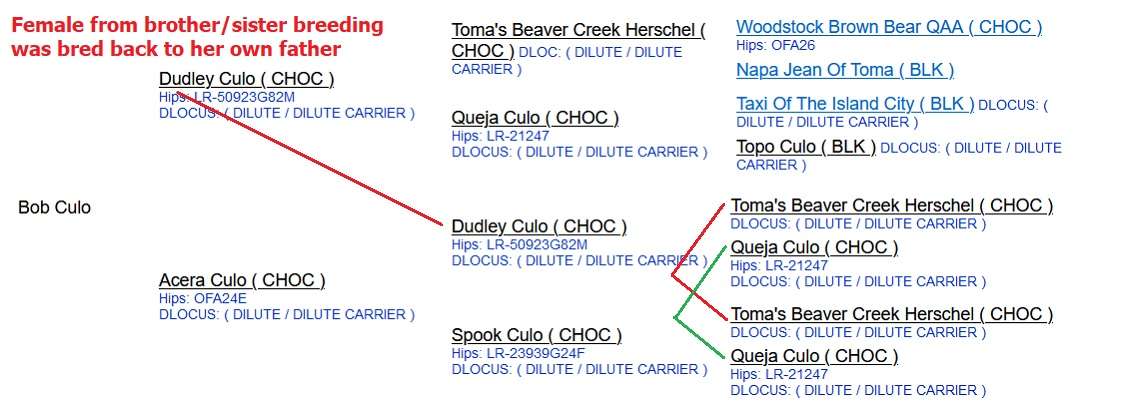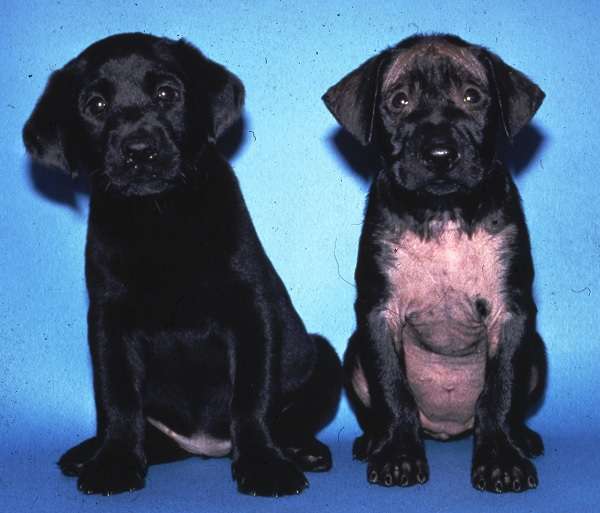
So, you've decided a get a silver Lab. They're trendy. They're more unusual than other Labs. And they come in other uncommon colors such as charcoal and champagne.
Before you dig out your wallet though, learn about how they were created and the health issues they often have. Learn the truth about the silver Labrador myth.
Early Labrador History
The Labrador Retriever originated in Newfoundland and the early dogs were black. Some had white markings from the St John's dog.
Several of these dogs were imported to England and Scotland during the 1800s. Impressed by their retrieving desire and overall work in the field, wealthy sportsmen imported more dogs and began breeding them. In the early 1900s, sportsmen in America began importing and breeding Labs.
The majority of these dogs were black, but breeders documented an occasional brown or yellow puppy. But black was - and still is - the most common color.
It's notable that none of these early Labs were described as silver colored.
Origin of the Silver Labrador Myth
According to the Factual Review by Margaret Wilson, "There was never any mention in the meticulous and exhaustive breeding records, whelping logs, descriptions of markings colors, etc., and stud books kept by gentlemen of unimpeachable integrity of any dog being produced that was, in fact or in fantasy, a dilute. Not in ANY of the retriever breeds developed from the St. John's dog during that time in Great Britain. The dilute allele was introduced after the establishment of the recognized breeds. In the case of the Labrador this introduction occurred in the USA during the latter part of the 20th century."
Because a variety of breeds were crossed with Labs early in their history, occasionally mismarks popped up. Some had tan markings like a Doberman, some were brindled like a Great Dane, and some were splashed with white. These mismarks are rare, but they do still occur. Unlike the "silver Labs", these dogs are considered purebred Labs.
There was no mention of "silver Labs" until the mid-twentieth century. And for years after that, they were only found in the US. There were none in the United Kingdom until 2006 when some silvers were exported from the US. If these silver dogs were purebred Labradors they should have appeared a long time ago in the breed's home country.
Origin of the silver color
The color most likely comes from the Weimaraner which has "shades of mouse-gray to silver-gray" per the breed standard. Every dog of this breed has two copies of the recessive dilution gene ("dd") which causes the silvery color.
The Labrador Retriever, however, does not have the dilution gene. A purebred Lab has "DD" genes which means they have two copies of the dominant, non-dilute gene.
Crossing Labs with Weimaraners will produce dogs with normal Lab colors, however, they will all carry the dilute gene ("Dd").
Breeding these dogs together can produce dogs that don't carry the dilute gene and dogs that carry one copy of that gene. These dogs will have normal Lab colors.
However, that cross can also produce dogs that have two copies of the dilute gene ("dd") with diluted colors.
The dilute colors have been named "charcoal", "champagne," and "silver." These dogs often have a lavender cast to the coat and light greenish eyes, both traits from the Weimaraner.
Honest Labrador breeders test their dogs for the dilute gene. A Lab with correct coat color - black, yellow, or chocolate - will be either DD or Dd. The DD means the dog does not carry the dilute gene. That small "d" means the dog has correct color, but also carries the dilute gene and is therefore a mix-bred.
The start of the silver Labrador myth
Just about every "silver Lab" can be traced back to two breeders - Crist Culo Kennels and Beaver Creek Labradors. They gained notoriety in the mid-1980s. Neither has a current website.
In 1987 the American Kennel Club ("AKC") investigated a litter of silver puppies. After looking at the puppies and paperwork they decided "there was no reason to doubt that the dogs were purebred Labrador Retrievers." That statement is not the same as saying the dogs were purebred. Rather it meant they had no proof the dogs were of mixed parentage. Genetic testing would likely have proven the records were falsified, but without it they relied on the breeder's word. Read on to learn about his truthfulness. Or lack thereof.
Crist Culo Kennels
Dean Crist was the first person to market "silver Labs" and was adamant that they were purebred Labs. He even "offered $100,000 to anyone who could simply prove" he was cross-breeding to produce "silver Labs." It was a safe bet without genetic testing.
The dogs at Crist Culo Kennels were intensely inbred. This was likely done to increase the number of dogs carrying the dilute gene and thus his profit margin.




Crist claimed, "... AKC will eventually have to concede to the growing public pressure to make Silver a recognized color for Labs in America." He didn't know that AKC doesn't have the power to make silver a recognized color of Labradors. The Labrador Retriever Club ("LRC") controls the breed standard and they don't recognize "silver Labs" as purebred.
He claimed, "Chocolate Labs were both controversial and rare in the U.S. in the early ‘80s."
Although not as common as black Labs, chocolates were not controversial nor rare and many were champions:
Am Mex CH Gunfields Super Charger CD WC (born 1969),
CH Wingmasters Cobe of Mandigo CD (born 1972),
CH Shamrock Acres Pot of Fudge CDX (born 1975),
CH Wingmaster's Swiss Ms CD (born 1977),
FC Mueller's Stormy Canada (born 1980),
Crist said, "...allergies ... occur at the same frequency in Silver Labs as they occur in Chocolate Labs." He blamed puppy buyers for feeding a poor diet. Silver Labs commonly have color dilution alopecia, a genetic disorder that causes the dog to lose most of its hair.
Although retired from breeding, other silver breeders continue to spread his false information.
Beaver Creek Labradors
This kennel showed up in the 1990s - about 10 years after Crist Culo. They practiced less intense line breeding - using distant relatives - compared with the inbreeding done at Crist Culo Kennels. According to Crist, this kennel culled silver puppies until they saw him advertising "silver Labs" for sale. He volunteered to sell the puppies for them so they could avoid the backlash of cross-breeding. Eventually, they chose to market their own puppies.
Other people decided to try breeding silvers. Some sourced their first dogs from early breeders, while others decided to breed their own "silver Labs." At least one breeder was caught falsifying records and was suspended from AKC.
Explaining the appearance of silver Labs
There are a variety of stories told to explain the sudden appearance of "silver Labs" in the 1980s.
Some silver breeders point to gray puppies noted by Mary Roslin-Williams. However, they only included the part that makes it seem like "silver Labs" have been around for many years. What they didn't share is that when those puppies shed their puppy coat they were black. Not silver, not charcoal.
A researcher traced many silver pedigrees back to dogs from a large mid-western kennel. To register crossbred puppies with the AKC, a false name and registration number from a Lab had to be used as the sire. Therefore the dogs he pointed to were likely the "parents" only on paper as the actual sire was probably a Weimaraner.
Another oft-repeated myth is that the level of inbreeding at the Culo kennel resulted in the silver color. Rather the tremendous amount of inbreeding in these early silvers suggests producing the silver color was deliberate.
It only took one fraudulent breeding to introduce the dilution gene to the Lab breed. Then lots of inbreeding to develop a line of "silver Labs." Since then there have been many more fraudulent registrations of Labrador x Weimaraner crosses registered as purebred Labs.
Interesting how there were no "silver Labs" until the mid-1900s. And for years after that they were only found in the US. There were none in the UK until many years later. The silvers there were all imported from the US or descended from imports. If these dogs were purebred Labradors they would have shown up a long time ago in the breed's home country.
Creation of "Silver Labs"
They are a cross of a chocolate Labrador Retriever and Weimaraner. A first generation dog could look more like a Lab or more like a Weimaraner. Breeding together two first generation mixed-bred dogs could result in puppies with the silver color.
If the Labrador grandparent was black or yellow, some of the second-generation puppies could be a lighter shade of black or yellow. These colors were called "charcoal" and "champagne."
Years ago it was really hard to tell a silver Lab from a Weimaraner. Unless you looked at the tail. In the US, Weimaraners have their tails docked to six inches. Other countries have outlawed cropping ears and docking tails, so looking at the tail in those locations is not helpful.
Over time, silver breeders have bred their dogs to purebred Labs so the silvers are looking more Lab-like. And they decided to lie and declare their mixed-breed dog are purebred Labradors. This is the silver Labrador myth.
Health Issues
Silver Labradors are prone to color dilution alopecia which is a painful and chronic condition linked to the dilute gene. Dogs appear normal as puppies, but at about six months begin to lose their hair. Some dogs may only have bald spots while others may lose all of their hair.
Affected dogs may develop infections and granulomas which are the body's attempt to wall off foreign bodies. There is no cure.


Silver Labrador Myth Around the World
"The overwhelming consensus among breed experts from legitimate Labrador clubs, the position of these accredited Labrador clubs, and a growing number of recognized purebred dog registries, is that the dilutes are the result of a cross breeding, with Weimaraner being the source of the dilute allele, and are therefore are not registerable in a purebred registry." LRC_News_Spring2018.pdf
In addition, the breed standards for Labrador Retrievers around the world only recognize the colors of black, chocolate and yellow. AKC lists any other color as a disqualification. Labs with the diluted color cannot be shown. Some countries do not allow them to be bred.
Labrador Retriever Club Inc.
The LRC is the parent club for the breed in the US and they are the liaison to the AKC. They do not condone the breeding of silver Labs and have "good evidence in scientific literature indicating that the Labrador has never been identified as carrying the dilute gene..."
In other words, these dogs are not purebred Labradors.
The United Kennel Club and Hunting Retriever Club
The UKC standard is clear. Any color or combination of colors other than yellow, black, or chocolate is a disqualification. UKC does not recognize any form of silver coloration as a variation of the chocolate color. It does not knowingly accept registrations for Labradors that have a silver coat coloring.
Further, they are not eligible to run in HRC hunt tests because the tests are only open to gun dog breeds. Dilutes are not considered purebred Labradors. They can participate in other UKC performance events but must be neutered.
Great Britain
Dilute colors in Labradors are not recognized
Canada
Not a breed standard recognized color for Labrador Retrievers
The Netherlands
Dilute colors are not naturally occurring in Labradors. Breeding dilute Labs is banned.
New Zealand
At least one parent must be clear of the dilute allele.
Australia
Dilute Labradors may not be registered.
American Kennel Club
On the other hand, the AKC is a registration body. Its position is if two dogs have full registration and are registered as the same breed, they will register their puppies.
Weighing the facts
Ultimately if silver breeders were truthful there would have been some backlash, but not to the extent caused by the lies. What Labrador breeders object to is calling these dogs "silver Labs" when they have Weimaraner characteristics beyond the silver color. It's particularly noticeable in the head, ear shape, and eye color.
Too many lies have been told and too much false information has been spread by the silver breeders. The LRC has offered to help them set up their own breed, but they've refused. So it's time to ferret out every one of these cross-bred dogs and stop calling them Labrador Retrievers.


